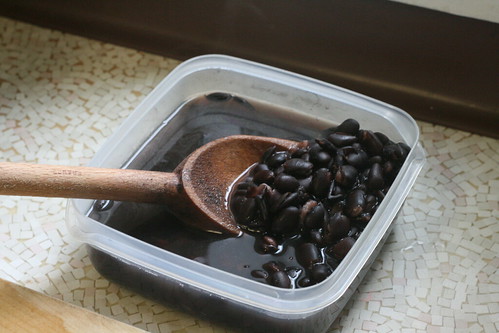
Take beans. Canned beans are fine! Bittman himself has said so, and every bean recipe in the book can work either with cooked-from-scratch beans or canned beans.
They're certainly cheaper than canned beans--a pound of uncooked black beans cost me $1.86 and yielded 4 cups of cooked beans. And if you store them with some of the cooking liquid, they freeze and keep just as well as canned, but presumably, they taste better. I don't know, I've never cooked my own.
To cook them, Bittman provides three methods: Quick-Soak (boil, turn off heat, let soak 2 hrs, return to heat, simmer til done), No-Soak (boil then simmer, til done), and Long-Soak (soak in cold water for 6-12 hrs, drain, simmer til done). Regardless of the method you use, the type of bean makes the cooking time vary greatly. I opted for Quick-Soak, Bittman's favorite: place beans in water to cover, bring water to a boil, turn the heat off, let sit covered for 2 hours. This is the soak part of the recipe (I suppose the idea of "quick" is relative). Then you add a bit of salt, pepper, and let the beans simmer, tasting every 15 minutes until they are done. I also added a bit of stock to the cooking liquid as the water evaporated, after one of Bittman's suggestions. It took over 2 hours for the beans to finish cooking, but most of them went into the freezer with cooking liquid to cover so that they'll be ready to go when I need them down the line.
So, what does everyone think I should do with the beans now that they're done?
P.S. Bittman's list of 5 beans to always keep on hand (p. 413): white beans, black beans, pinto/kidney beans, chickpeas and lentils.

Make chili of course!!
ReplyDeleteInteresting. I learned to cook from my GMa starting at age 4, standing on a chair at the stove while she cooked a Cuban staple, black beans. She always cleaned by rinsing and removing 'bad beans'x 3. The 4th water covered the beans to soak overnight. I was taught that long soak made the beans tender, which helped make the bean's own 'gravy' that soaked into the white rice it would go atop. We cooked white, pink, navy beans the same. As a woman, I moved from Miami, FL to Charlotte, NC. There I was introduced to pinto beans made by my ex husband and his family whom were from the Lumbee Indian tribe. They do the quicker soak method and in doing the process in 8+ hours less would start on high heat then simmer x 2 hours. To make the same type of thickened 'gravy' they added lots of salty fatback and took either a ricer tool or a heavy wooden spoon and smash some of the beans in the pot (about a quarter cup worth, nevered measured, but eyeballed). Those few soupy beans wiuld make the rest of the beans into the gravy. If smashing + the salted fatback caused any chemical reaction, I don't know. The beans do taste good! It was a new learning experience for me. I always put some of the beans into Tupperware type containers for freezing and I do believe ALL beans taste even better after they 'sit' frozen or just cold refridgerated, similar to spaghetti sauce & chili.
ReplyDelete